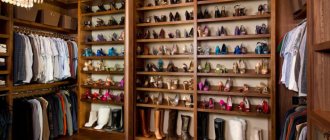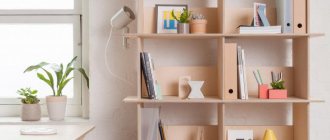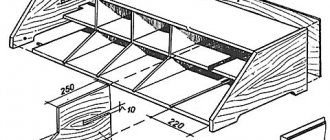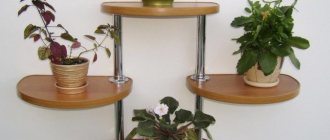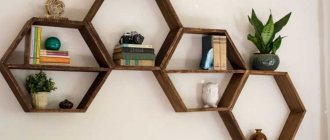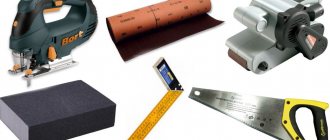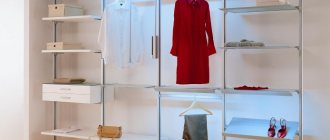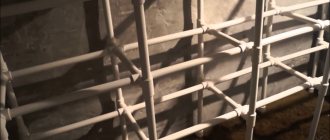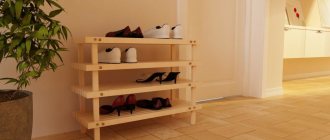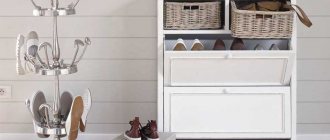To properly store shoes, you need to make sure there are special shelves in the hallway. With the help of specially installed cabinets, it is possible to ensure the safety of products, as well as take care of their compact arrangement. However, when planning the arrangement of a dressing room, it is recommended to take care of the correct use of the usable space of the room.
How to arrange shelves in a dressing room: optimal options
When planning a dressing room, you need to pay special attention to the interior arrangement of the room. So, depending on the size and shape of the room, you should decide in advance on the number of shelves and their purpose.
There are several ways to conveniently arrange shelves in a dressing room:
- Along the long wall. This option is considered optimal if sliding doors are installed. After opening them, the internal space is freely accessible. It is worth highlighting the various Ikea designs, characterized by high quality, compactness and originality. If necessary, it can be used to store the structure in two rows.
- On both sides. This shelving system is best suited for walk-through rooms that have two entrances. However, this arrangement cannot be used if the dressing room is small.
- The location is "peaceful". This arrangement of shelves is presented in the form of the letter “P”, that is, cabinets and shelves are installed on three walls. For rooms with a large area, this is the most spacious option for arranging the room.
- "L-shaped" arrangement. In wardrobes that are not wide enough, this option is often used. But it is important that the minimum width of the room is at least 1.2 m.
- Retractable structures. This option will be the most acceptable solution in small rooms. After all, with the help of retractable shelves and racks, it is possible to take care of the successful placement of all things and shoes.
Depth of shelves in the dressing room: design tips
One of the most important issues related to the installation of shelves in the dressing room is the optimally selected depth. When choosing the optimal depth of shelves, it is important to take into account the size of the room and the features of the wardrobe design. For standard products, it is customary to use a depth of 60 cm. This size will be an excellent solution for hangers needed to arrange bulky items. But for large rooms, many owners prefer to use a cabinet depth of up to 90 cm.
Below are recommendations for successfully organizing the depth of shelves in the dressing room:
- You should be careful with a depth of less than 50 cm. Often, such dimensions are used in small closets, which, instead of bulky winter items, are intended for storing light items or shoes.
- For sliding wardrobes, you will need shelves with a depth of at least 65 cm. After all, at least 10 cm is needed for the mechanism designed to slide doors.
- If you plan to create a compartment with hanging clothes, you need to make the depth of the shelves 90 cm. At least 50 cm is used for space for large bags and suitcases, depending on the height of the closet.
- If the width of the shelves exceeds 90 cm, it is recommended to install a special partition. Thanks to this precaution, the inner bar will not bend under the weight.
Variety No. 1: mechanisms
Special rotating mechanisms are the basis of the design of the type under consideration
This design consists of two side walls made of plastic, on which there are grooves for mounting shelves and a bottom made of chipboard. The front wall, which can also be made of chipboard or MDF, plays the role of the facade of the shoe rack.
The structure of the mechanism is very simple: side walls and two shelves
Most often, this option can be found in the form of an independent piece of furniture; in this case, the mechanism itself is additionally enclosed in a body and resembles a chest of drawers from the outside.
Shoe mechanisms can be used as independent furniture if they are first installed in frames made of chipboard, MDF or wood
But no one bothers you to build such an accessory into a wardrobe. Let's see how it's done:
Description of installation
| Photo | Instructions |
| |
| we install four mechanisms for shoe racks. |
Be sure to make sure that the department in which the new accessory is installed is at least 3 cm narrower than the second half of the wardrobe. Otherwise, the compartment doors will not allow the shoe racks to open.
Shoe shelves for a dressing room: types of designs
Before choosing a shoe rack model for a dressing room or another part of the house, you need to decide which design option is best suited.
Today the following are equally considered popular:
- Open structures;
- Closed shelves.
There are no doors in the open shelves, so all shoes are freely accessible. Such designs provide good air penetration to the shoes, thereby preventing the accumulation of moisture.
Thanks to open shelves, it is possible to significantly save useful space in the room, as well as ensure long service life of shoes.
However, the disadvantages of such shelves should be highlighted separately. The products have limited capacity, so only seasonal shoes can be stored here. As for closed shoe shelves, they are presented in the form of ordinary cabinets. This option will be an ideal solution for dressing rooms, because the structures can store shoes for a long time, while maintaining their original appearance.
The closed shelves have doors to create the appearance of a finished product. However, the internal space here is negligible, so they are only suitable as a place for long-term shoe storage. The described designs also have additional devices. Thus, the shelves can be mesh, multi-level, or equipped with an additional decorative stand used for storing hats.
Varieties
Standard materials are MDF, chipboard and metal profile. There are 3 types as standard:
But the first ones are conditionally divided into 4 more options.
Retractable systems
These are shoe shelves that can extend beyond the perimeter of the cabinet opening. Provides access to the entire shoe storage volume. Let's consider these types:
- mesh boxes;
- flat gratings;
- shoe column.
Mesh boxes
The height of the sides of the shelves in the mesh boxes prevents the outer shoes from falling. The lattice structure promotes ventilation of the interior space from all sides.
The mesh is made of wire reinforcement covered with vinyl. The plastic shell of the grille protects the surface of the shoe from accidental scratches. The shelves themselves pull out like drawers in cabinets and cabinets. The lower side corners of the mesh boxes are connected to the walls of the wardrobe with telescopic guides.
Pallets
They are made in the form of ordinary furniture boxes. The only difference is that the sides of the pallets are low (40 - 70 mm). There are special mechanisms thanks to which shelves on telescopic runners extend at an angle.
Since the pallets are made of solid material, there is no ventilation of the shoes from the bottom and sides. Therefore, bags of absorbent are placed at the bottom of the shelves. Metal rods are inserted into the sides to keep the shoes suspended. In this position, the soles do not contact the bottom of the box.
Flat gratings
They are made from the same material as in the previous example. The difference is that the planes have small sides only in front. They are placed on brackets that are attached to the vertical wall of the retractable system. The wall rests on a horizontal plane that extends from the cabinet opening along telescopic guides.
For maximum capacity, they are installed at an angle. The front edge prevents the shoes from sliding down.
Shoe column
The shelves can hold many pairs of shoes. There are two known options for columns: those that extend from the front and from the side. The choice of model depends on the size of the opening.
When the passage is narrow, it is better to mount the column on the side wall of the cabinet on retractable telescopic guides. If the transverse size of the opening is wide, then the front wall of the shelf is placed on a horizontal plane, to the bottom of which four roller legs are attached.
Handles are installed on both sides of the vertical panel, behind which the draw-out column is pulled out.
Note! The material for column support railings is MDF or laminated chipboard sheets. The shelves themselves are made of nickel-plated or chrome-plated metal profiles. They are mounted in a horizontal or inclined position.
Folding
As such a system, they take a ready-made shoe rack and insert it into the cabinet opening. Folding shelves are petal-type rotating mechanisms with built-in shoe racks. A closet can contain 2 or more pieces.
The peculiarity is that the lower shelf of the rotating section is also the front of the cabinet. Up to 4 shelves can be installed in the folding one.
Stationary
The structure consists of horizontal planes at different levels. This is the simplest solution for shelves in a closet. The disadvantages of such a storage system include the open position of shoes in the internal space of the wardrobe, the limited number of stored pairs and the inconvenience of their use.
The advantage of stationary shelves is their simplicity and low cost. Such storage systems can be mobile if they are a free-standing structure. Then the shoe rack can be removed from the closet and moved to another part of the hallway.
Interesting DIY shoe shelves for your dressing room: original ideas
Today, it is often practiced to make shoe shelves for the dressing room yourself. Such designs are made from scrap materials or you can purchase a special set. An excellent solution for shoe shelves in a dressing room would be an adjustable set that has advantages over standard cabinets.
Thanks to the ability to adjust the size of the structure, Larvij is able to independently produce a dressing room that will fit perfectly into any room.
There are many ideas for making shoe shelves:
- Plywood product. The result will be a modular shelf. It is necessary to prepare rectangular parts in advance, which are sanded, and then the shelf is assembled.
- Made of wood. The shelves will fit perfectly into the American or other style of the room. Design elements can be easily purchased in stores or made on your own. But in the second case, it is impossible to do without special materials and professional tools.
- From chipboard. For this option, you need to acquire all the necessary tools, and also take care of creating a drawing of the product. Moreover, the manufacturing processes for narrow and corner structures will be identical.
- From slats. Such products are characterized by lightness, availability of materials and excellent ventilation.
- From profile. It will be an ideal solution for high-tech style. Galvanized materials are moisture resistant, and regular multi-colored profiles fit harmoniously into the interior.
In addition to the above methods for making shoe shelves, you can create a corner, round or rotating structure with your own hands.
How to make it yourself
Photos of ready-made, attractive shelves can be seen below, but it is not always possible to purchase them, and sometimes people cannot choose the optimal model for an unusual and non-standard corridor. Then you can start creating the shelf yourself. Creating a shelf with your own hands guarantees that you will receive a product that has the desired appearance, characteristics and dimensions.
Most often, wooden blocks are used to create a shelf. To work, you need to prepare 6 pieces of these bars, screws for fastening and protective varnish for wood. The entire work process is divided into stages:
- side parts are formed from wooden blocks;
- other bars are distributed on the workpiece, on which cuts of the required depth are made in advance;
- two blanks are fixed to each other with self-tapping screws, which ensures a complete shelf;
- after completing the installation work, it is necessary to grind the sections and sides of the elements, for which sandpaper is used;
- The wooden structure is coated with a protective varnish.
Although all wooden elements are varnished, it is recommended not to place wet shoes on the shelf while using the structure, as they may cause deformation of the product. In addition to wood, you can use plastic or chipboards. The last option is incredibly simple, since you just need to buy a fairly thick slab, which is cut according to the drawing into separate shelves. They are fixed to the cabinet with screws or other fasteners.
Thus, shoe shelves are a must-have in every closet. They perform many functions, are comfortable and multifunctional, and are also made from various materials. They are presented in many types, but you can not only buy a ready-made structure, but also start creating it yourself, for which the original design ideas of the homeowners are embodied. In this case, you can make the shelves not only stationary, but also retractable or folding.
Chipboard
Impregnation with stain
Preparing parts
Preparing the grooves
Glue is applied to the grooves and the shelves are attached

